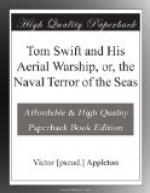“No—oh, no,” replied Tom, as he crumpled up the paper and thrust it into his pocket. “No bad news, Dad.”
“Well, I’m glad to hear that,” went on Mr. Swift. “I don’t like telegrams.”
When Tom showed the message to Lieutenant Marbury, that official, after one glance at the signature, said:
“Pierson, eh? Well, when he sends out a warning it generally means something.”
“Who’s Pierson?” asked Tom.
“Head of the Secret Service department that has charge of this airship matter. There must be something in the wind, Tom.”
Extra precautions were taken about the shops. Strangers were not permitted to enter, and all future work on the Mars was kept secret. Nevertheless, Tom was worried. He did not want his work to be spoiled just when it was about to be a success. For that it was a success, Lieutenant Marbury assured him. The government man said he would have no hesitation in recommending the purchase of Tom’s aerial warship.
“There’s just one other test I want to see made,” he said.
“What is that?” Tom inquired.
“In a storm. You know we can’t always count on having good weather, and I’d like to see how she behaves in a gale.”
“You shall!” declared the young inventor.
For the next week, during which finishing touches were put on the big craft, Tom anxiously waited for signs of a storm. At last they came. Danger signals were put up all along the coast, and warnings were sent out broadcast by the Weather Bureau at Washington.
One dull gray morning Tom roused his friends early and announced that the Mars was going up.
“A big storm is headed this way,” Tom said, “and we’ll have a chance to see how she behaves in it.”
And even as the flight began, the forerunning wind and rain came in a gust of fury. Into the midst of it shot the big aerial warship, with her powerful propellers beating the moisture-laden air.
“Say, Tom, are you sure you’re all right?”
“Of course I am! What do you mean?”
It was Ned Newton who asked the question, and Tom Swift who answered it. The chums were in the pilot-house of the dipping, swaying Mars, which was nosing her way into the storm, fighting on an upward slant, trying, if possible, to get above the area of atmospheric disturbance.
“Well, I mean are you sure your craft will stand all this straining, pulling and hauling?” went on Ned, as he clung to a brass hand rail, built in the side of the pilot-house wall for the very purpose to which it was now being put.
“If she doesn’t stand it she’s no good!” cried Tom, as he clung to the steering wheel, which was nearly torn from his hands by the deflections of the rudders.
“Well, it’s taking a big chance, it seems to me,” went on Ned, as he peered through the rain-spotted bull’s-eyes of the pilot-house.




